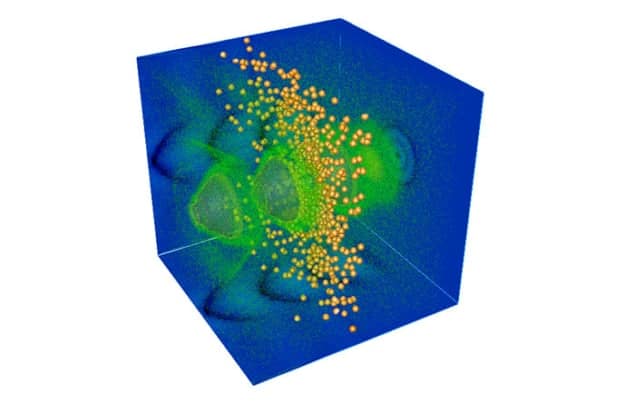Flash Physics is our daily pick of the latest need-to-know developments from the global physics community selected by Physics World‘s team of editors and reporters

Laser-plasma wakefield accelerators deliver three electron beams
Laser-plasma wakefield accelerators (LWFAs) create two lower-energy, higher-flux electron beams in addition to the higher-energy electron beam that they are designed to deliver. That is the conclusion of experiments and computer simulations done by an international team of physicists led by Dino Jaroszynski at the University of Strathclyde in the UK. LWFAs work by firing an intense laser pulse at a target to create a plasma. The powerful electric field of the pulse causes electrons and ions in the plasma to separate, leaving a huge electric field in its wake. Under the right conditions, this field will accelerate a focussed beam of electrons (or protons) to energies as great as several gigaelectronvolts. As a result, physicists are very keen on developing LWFAs as low-cost, compact particle accelerators that could have a wide range of applications from medical therapy to particle physics. One puzzling aspect of LWFAs was that a relatively small portion of the energy of the laser pulse appears to go into the production of the high-energy electron beam. Now, Jaroszynski and colleagues have shown that LWFAs also produce two lower-energy electron beams that are not as tightly focused as their higher-energy counterpart. In experiments done at Strathclyde, the team used a LWFA that delivers a focused electron beam with energy 100–200 MeV and a total charge of about 5 pC. However, the researchers also observed a broad cone of electrons with energies of several megaelectronvolts that are accelerated in the same direction as the higher-energy beam and the laser pulse. Furthermore, a beam of electrons with energies of hundreds of kiloelectronvolts was seen to be accelerated in the opposite direction. The total charges in both of these lower-energy beams was 1000 times greater than the higher-energy beam – explaining where much of the laser energy has gone. The researchers point out that these lower-energy electrons could be used for imaging applications – either on their own, or via X-rays that they could be used to create. However, the team also points out that these electrons could also damage equipment and the energy that they take away limit the efficiency of LWFAs. The research is described in Scientific Reports.
Making nanosheets from cat litter and talcum powder
2D nanosheets have been made out of cat litter, talcum powder and sand by using liquid phase exfoliation (LPE). LPE is a top-down method that produces nanosheets by shearing or sonicating layered crystals in solutions. The resulting dispersed sheets can then be processed to create nanostructured materials for a range of applications such as battery electrodes and photodetectors. Already proven to be a scalable, simple and cheap method, researchers from Trinity College Dublin in Ireland and the University of Manchester in the UK have investigated LPE’s versatility. In the past the method has been used to create a range of 2D materials, such as graphene and boron nitride, which are nominally uncharged and require a pure starting material. Jonathan Coleman from Trinity College Dublin and colleagues therefore wanted to know if nanosheets could be made from charged layered precursors that are always accompanied by counter ions (such as layered oxides, hydroxides and silicates), and impure materials. The team tried shop-purchased talcum powder (which contains the clay mineral talc), cat litter (contains layered silicate compounds) and sand from a beach in County Kerry, Ireland (contains small amounts of clay). By using a standard LPE procedure whereby the materials were ultrasonically agitated in a surfactant solution and then centrifuged, the researchers produced nanosheets of talc from the talcum powder, bentonite/palygorskite from the cat litter and mica from the sand. “What is particularly surprising,” explains Coleman, “is that the bentonite and palygorskite layered crystals, contained in the cat litter as well as the mica in the beach sand, should both consist of charged layers with charge-balancing counter ions, yet could still be exfoliated by LPE.” The research, presented in 2D Materials demonstrates the versatility of the method and opens up the easy production of more nanosheet materials.
Canadian budget has “little new spending for science”, says physics association

The proposed Canadian 2017 federal budget has “little new spending for science”, according to the Canadian Association of Physicists (CAP). Delivered earlier this week by Liberal finance minister Bill Morneau, the budget “proposes new funding to help Canadians prepare for the economy of tomorrow by promoting the development of science, technology, engineering and mathematics (STEM) skills and digital literacy, particularly for women, girls and under-represented groups”. However, an analysis published by CAP suggests that little new money has been allocated for academic research-related initiatives funded by the Natural Sciences and Engineering Research Council of Canada and the Canada Foundation for Innovation. On a positive note, CAP points out that the federal government has promised C$10m over two years to the Institute for Quantum Computing in Waterloo, Ontario, and C$89m over five years for space-related research. C$221m over five years will also be given to the Mitacs programme, which is a research internship programme that involves Canadian universities, industry and provincial and federal governments.
- You can find all our daily Flash Physics posts in the website’s news section, as well as on Twitter and Facebook using #FlashPhysics. Tune in to physicsworld.com later today to read today’s extensive news story on an expelled supermassive black hole.



